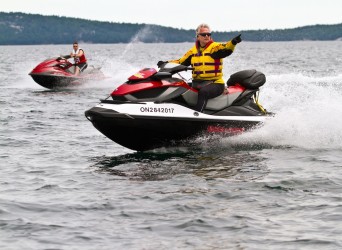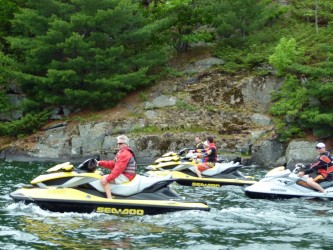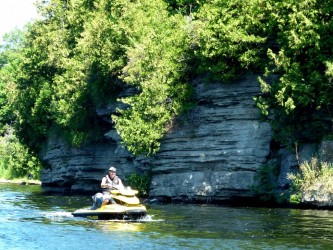Common Sense Tips For Jet Ski Riding…
Related: 5 Safe Riding Tips
How are your best safe riding habits for jet ski, waverunner or Sea Doo riding on self guided PWC adventures in Ontario and throughout Canada? Have you ever noticed that Sea-Doo riders are often the only ones on the water wearing PFD’s? But doing one thing right isn’t enough for experienced riders like me on my Sea Doo watercraft or PWC beginners to earn a reputation as responsible boaters.
We share the waterways with many others. These include recreational boaters, anglers and cottagers. And we want them to respect our right to be there too. So it’s important for this reason, as well as our own comfort and safety, to brush up on our Sea-Doo riding etiquette, and other jet ski tips. Here are a few pointers I try to make part of my Sea Doo riding habits. Maybe you can suggest some others…
Safe Riding Habits – 360˚ Sea Doo Situational Awareness…
Unlike roads and trail, traffic on the water doesn’t move in defined linear patterns. That means anything can come at you from any direction at any time. So a Sea Doo rider must be constantly vigilant. Always on the lookout all around, aware of the changing positions of everything nearby. And always checking rear view mirrors before deviating from your present forward course.
Safe Riding Habits – Approaching Other Boats…
If another boat is crossing your path from your port side (left), you have the right of way. If another boat is crossing your path from your starboard side (right), it has the right of way. Boats approaching head on should each veer to their starboard (right). If you are coming up from behind (from the stern of a boat ahead), you are responsible for keeping out of its way and giving it a wide berth as you pass.
Safe Riding Habits – Ride Legal…
Every jurisdiction has rules for boating. Be sure you know what applies to you while riding your Sea Doo watercraft on any given waterway. This way, everything will be ship shape when you encounter marine enforcement. Besides wearing a PFD, legalities are likely to include visible registration numbers, on board safety gear, alcohol restrictions, proper ID and a valid boater’s licence.
Safe Riding Habits – Obey Marine Signs…
There aren’t as many traffic signs or markers on the water as on highways or snowmobile trails. But that doesn’t diminish their importance. There are restriction signs to show areas where you can’t ride or what speed to ride at. Various navigation buoys indicate direction, channel junctions, danger and where the deepest water is.
Safe Riding Habits – Slow Down in Speed Limit Zones…
Like on our roads, there are sections on most waterways where heavier traffic, intersections, narrower passages or shoreline development have resulted in speed restrictions proscribed by law. These restrictions can apply across the whole section of water. Or only within a certain distance of shore.
Safe Riding Habits – Slow Down in No Wake Zones…
Often these coincide with Speed limit zones. But can also be sections where the large wake generated by a faster moving craft can disrupt or damage shoreline property, docks or moored boats.
Safe Riding Habits – Avoid Riding After Dark…
Your Sea Doo watercraft does not come equipped with navigation lights. So for your own safety and that of others, avoid riding after dark. Depending on your jurisdiction,Sea Doo riding after dark on a PWC may also be illegal.
Safe Riding Habits – Be Careful Fuelling Up…
With our increased environmental awareness, boaters and marinas are tend to be very careful about fuel spills today. So we can do our part by keeping the gas in the hose or in your tank. Not on the ground or in the water. Be especially careful if filling your PWC from a jerry can for your Sea Doo ride.
Safe Riding Habits – Respect Other Waterway Users…
From swimmers and divers to anglers, kayakers and tow sporters, many other folks enjoy and share the waterways. As one of the quickest and most manoeuvrable craft out there, Sea Doo riders need to give to all of them a wide berth to avoid scaring, spraying, waving or hitting them.
Safe Riding Habits – Take Litter Out With You…
Many Sea Doo riders stop to enjoy a water or shore snack or lunch while out for a cruise. So plan how to pack up your garbage and carry it with you to a trash can on land.
Safe Riding Habits – Use Hand Signals…
Although to my knowledge there are no officially approved PWC hand signals, my jet ski riding buddies and I use the same ones originally designed for use by automobile drivers to signal one another. These are still used and recognized by many bicyclists, snowmobilers and ATV riders. They include either arm straight up from the shoulder to signal STOP. Left arm pointed straight out to the side to indicate LEFT turn. And left upper arm raised to shoulder height with forearm pointing up to indicate RIGHT turn. In many instances, keeping both hands on the handlebars is more important for complete control. So we only use hand signals discretionally in reduced speed and traffic situations.
If you enjoyed this post, check out my other riding tips.
The tips and advice in this article are the opinions of the author, may not work in every situation and are intended only for the convenience and interest of the reader, who has the personal responsibility to confirm the validity, accuracy and relevancy of this information prior to putting it to their own use.




